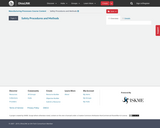

Applied Science

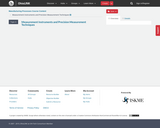
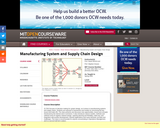
15.763 focuses on decision making for system design, as it arises in manufacturing systems and supply chains. Students are exposed to frameworks and models for structuring the key issues and trade-offs. The class presents and discusses new opportunities, issues and concepts introduced by the internet and e-commerce. It also introduces various models, methods and software tools for logistics network design, capacity planning and flexibility, make-buy, and integration with product development. Industry applications and cases illustrate concepts and challenges. Recommended for operations management concentrators. Second half-term subject.
- Subject:
- Applied Science
- Business and Finance
- Environmental Science
- Manufacturing
- Professional Studies
- Material Type:
- Full Course
- Provider:
- M.I.T.
- Provider Set:
- M.I.T. OpenCourseWare
- Author:
- Graves, Stephen
- Simchi-Levi, David
- Date Added:
- 01/01/2005
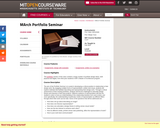
The aim of the Portfolio Seminar is to assist in developing a critical position in relationship to their design work. By engaging multiple forms of representation, written and visual, students will explore methods that facilitate describing and representing their design work. Through a critical assessment of their existing portfolios, students will first be challenged to articulate design theses and interests in their past projects. Different mediums of representation will then be studied in order to hone an understanding of the relationship between form and content, and more specifically, the understanding of particular modes of representation as different filters through which their work can be read. Some of the questions that will be addressed are: How does one go about describing an image? How does one theorize representation? How does one articulate a design thesis in writing verses visual media? How can the two interact to enhance each other? How do different media, printed verses web publishing, affect the representation of work? How is your work best communicated.
- Subject:
- Applied Science
- Architecture and Design
- Material Type:
- Full Course
- Provider:
- M.I.T.
- Provider Set:
- M.I.T. OpenCourseWare
- Author:
- Yoon, Jeannie Meejin
- Date Added:
- 01/01/2003
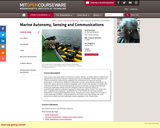
This course covers basic topics in autonomous marine vehicles, focusing mainly on software and algorithms for autonomous decision making (autonomy) by underwater vehicles operating in the ocean environments, autonomously adapting to the environment for improved sensing performance. It will introduce students to underwater acoustic communication environment, as well as the various options for undersea navigation, both crucial to the operation of collaborative undersea networks for environmental sensing. Sensors for acoustic, biological and chemical sensing by underwater vehicles and their integration with the autonomy system for environmentally adaptive undersea mapping and observation will be covered. The subject will have a significant lab component, involving the use of the MOOS-IvP autonomy software infrastructure for developing integrated sensing, modeling and control solutions for a variety of ocean observation problems, using simulation environments and a field testbed with small autonomous surface craft and underwater vehicles operated on the Charles River.
- Subject:
- Applied Science
- Engineering
- Environmental Science
- Material Type:
- Full Course
- Provider:
- M.I.T.
- Provider Set:
- M.I.T. OpenCourseWare
- Author:
- Henrik Schmidt
- Michael Benjamin
- Date Added:
- 01/01/2012
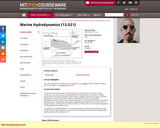
In this course the fundamentals of fluid mechanics are developed in the context of naval architecture and ocean science and engineering. The various topics covered are: Transport theorem and conservation principles, Navier-Stokes' equation, dimensional analysis, ideal and potential flows, vorticity and Kelvin's theorem, hydrodynamic forces in potential flow, D'Alembert's paradox, added-mass, slender-body theory, viscous-fluid flow, laminar and turbulent boundary layers, model testing, scaling laws, application of potential theory to surface waves, energy transport, wave/body forces, linearized theory of lifting surfaces, and experimental project in the towing tank or propeller tunnel.
- Subject:
- Applied Science
- Architecture and Design
- Engineering
- Material Type:
- Full Course
- Provider:
- M.I.T.
- Provider Set:
- M.I.T. OpenCourseWare
- Author:
- Yue, Dick
- Date Added:
- 01/01/2005

MIT website
- Subject:
- Applied Science
- Material Type:
- Activity/Lab
- Date Added:
- 03/03/2020
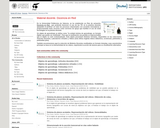
Polytechnic University of Valencia has established an Action Plan, Teaching Network (Docencia en red), which aims to promote the use of ICT in teaching, supporting the teacher in all processes related to innovative actions and providing both resources and services support to facilitate the use of these technologies in teaching. This plan is structured through annual calls for proposals (2018-2019 Call) .
The purpose of this call is to encourage teachers at the Universitat Politècnica de València to produce during the academic year 2018-2019 ("and in all previous calls") educational materials destined to enhance the repository of digital learning objects RiuNet, to stimulate the use of learning modules in UPV subjects, to enrich the collection of freely accessible materials.
All materials elaborated have to meet the criteria set out in the guidelines for the creation of learning materials (http://www.upv.es/contenidos/DOCENRED/infoweb/docenred/info/710371normalc.html).
In order to guarantee the quality of the materials presented to the plan, the UPV centres, through the Learning Object Groups, will value the materials produced, with quality indicators. The approval of the objects for publication will be carried out by the Commission of the Network Teaching Plan.
All OER are accessible through the institutional repository Riunet, through OAI-PMH they can be harvested by other information resources (e.g. BASE, etc.). They are described with Dublin Core and DC.LOM metadata.
Best regards
- Subject:
- Applied Science
- Arts and Humanities
- Computer Science
- Engineering
- Environmental Science
- Social Science
- Material Type:
- Activity/Lab
- Assessment
- Interactive
- Simulation
- Author:
- Universitat Politècnica de València
- Date Added:
- 04/02/2020
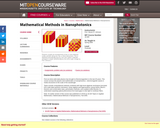
Topics vary from year to year. Topic for Fall: Eigenvalues of random matrices. How many are real? Why are the spacings so important? Subject covers the mathematics and applications in physics, engineering, computation, and computer science. This course covers algebraic approaches to electromagnetism and nano-photonics. Topics include photonic crystals, waveguides, perturbation theory, diffraction, computational methods, applications to integrated optical devices, and fiber-optic systems. Emphasis is placed on abstract algebraic approaches rather than detailed solutions of partial differential equations, the latter being done by computers.
- Subject:
- Applied Science
- Computer Science
- Material Type:
- Full Course
- Provider:
- M.I.T.
- Provider Set:
- M.I.T. OpenCourseWare
- Author:
- Johnson, Steven
- Date Added:
- 01/01/2008
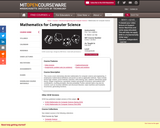
This course covers elementary discrete mathematics for computer science and engineering. It emphasizes mathematical definitions and proofs as well as applicable methods. Topics include formal logic notation, proof methods; induction, well-ordering; sets, relations; elementary graph theory; integer congruences; asymptotic notation and growth of functions; permutations and combinations, counting principles; discrete probability. Further selected topics may also be covered, such as recursive definition and structural induction; state machines and invariants; recurrences; generating functions.
- Subject:
- Applied Science
- Computer Science
- Information Science
- Material Type:
- Full Course
- Provider:
- M.I.T.
- Provider Set:
- M.I.T. OpenCourseWare
- Author:
- Dijk, Marten van
- Leighton, Tom
- Date Added:
- 01/01/2010
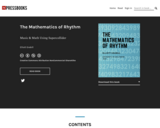
Using the free software Supercollider, you can create create music using computer coding. This text and lesson provide instructional videos, downloadable files, and step by step instructions for coding in the unique language.
- Subject:
- Applied Science
- Computer Science
- Electronic Technology
- Mathematics
- Professional Studies
- Material Type:
- Activity/Lab
- Author:
- Elliott Grabill
- Date Added:
- 05/10/2021
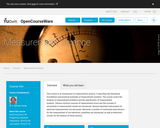
This course is an introduction to measurement technology and describes the theoretical foundations and practical examples of measurement systems. The analyzing of measurements problems and specifying of measurements systems are the main subjects that are treated in this course, where the main focus will be on the different kind of measurement errors and the concept of uncertainty in measurement results. Electronic measurement instrumentation will be introduced; a number of conventional sensors for the measurement of non-electronic variables will be described, as well as electronic circuits for the reading of the sensors.-Analyzing of measurement problems-Describing of measurement problems -Analyzing the measurement quantity-Analyzing the measurement boundaries for a quantity to be measured in different circumstances-Professional use of the measurement system-Describing the operating principle of conventional instruments for electronic measurements.-Comparing the available measurement instruments on the basis of quality and accuracy.-Realization of simple measurement setups.-Using the electronic sensor for the measurement of non-electronic variables.-Using a simple signal processing circuits for the reading of the sensors.-Analyzing, presenting and interpreting of measurement results;-Recognizing and describing of error sources.
- Subject:
- Applied Science
- Material Type:
- Full Course
- Provider:
- Delft University of Technology
- Provider Set:
- Delft University OpenCourseWare
- Author:
- M.A.P. Pertijs
- Date Added:
- 05/22/2019
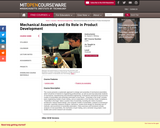
Introduces mechanical and economic models of assemblies and assembly automation on two levels. "Assembly in the small" comprises basic engineering models of rigid and compliant part mating and explains the operation of the Remote Center Compliance. "Assembly in the large" takes a system view of assembly, including the notion of product architecture, feature-based design and computer models of assemblies, analysis of mechanical constraint, assembly sequence analysis, tolerances, system-level design for assembly and JIT methods, and economics of assembly automation. Case studies and current research included. Class exercises and homework include analyses of real assemblies, the mechanics of part mating, and a semester long project.
- Subject:
- Applied Science
- Architecture and Design
- Engineering
- Material Type:
- Full Course
- Provider:
- M.I.T.
- Provider Set:
- M.I.T. OpenCourseWare
- Author:
- Whitney, Daniel
- Date Added:
- 01/01/2004
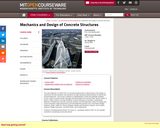
The main objective is to provide students with a rational basis of the design of reinforced concrete members and structures through advanced understanding of material and structural behavior. This course is offered to undergraduate (1.054) and graduate students (1.541). Topics covered include: Strength and Deformation of Concrete under Various States of Stress; Failure Criteria; Concrete Plasticity; Fracture Mechanics Concepts; Fundamental Behavior of Reinforced Concrete Structural Systems and their Members; Basis for Design and Code Constraints; High-performance Concrete Materials and their use in Innovative Design Solutions; Slabs: Yield Line Theory; Behavior Models and Nonlinear Analysis; and Complex Systems: Bridge Structures, Concrete Shells, and Containments.
- Subject:
- Applied Science
- Environmental Science
- Material Type:
- Full Course
- Provider:
- M.I.T.
- Provider Set:
- M.I.T. OpenCourseWare
- Author:
- Buyukozturk, Oral
- Date Added:
- 01/01/2004

Introduction to continuum mechanics and material modeling of engineering materials based on first energy principles: deformation and strain; momentum balance, stress and stress states; elasticity and elasticity bounds; plasticity and yield design. Overarching theme is a unified mechanistic language using thermodynamics, which allows understanding, modeling and design of a large range of engineering materials.
- Subject:
- Applied Science
- Environmental Science
- Material Type:
- Full Course
- Provider:
- M.I.T.
- Provider Set:
- M.I.T. OpenCourseWare
- Author:
- Ulm, F.-J. (Franz-Josef)
- Date Added:
- 01/01/2003
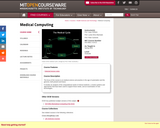
The focus of the course is on medical science and practice in the age of automation and the genome, both present and future. It includes an analysis of the computational needs of clinical medicine, a review systems and approaches that have been used to support those needs, and an examination of new technologies.
- Subject:
- Applied Science
- Computer Science
- Health Sciences
- Material Type:
- Full Course
- Provider:
- M.I.T.
- Provider Set:
- M.I.T. OpenCourseWare
- Author:
- Ohno-Machado, Lucila
- Date Added:
- 01/01/2003
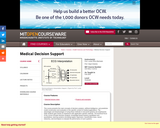
Presents the main concepts of decision analysis, artificial intelligence, and predictive model construction and evaluation in the specific context of medical applications. Emphasizes the advantages and disadvantages of using these methods in real-world systems and provides hands-on experience. Technical focus on decision analysis, knowledge-based systems (qualitative and quantitative), learning systems (including logistic regression, classification trees, neural networks), and techniques to evaluate the performance of such systems. Students produce a final project using the methods learned in the subject, based on actual clinical data. (Required for students in the Master's Program in Medical Informatics, but open to other graduate students and advanced undergraduates.)
- Subject:
- Applied Science
- Computer Science
- Material Type:
- Full Course
- Provider:
- M.I.T.
- Provider Set:
- M.I.T. OpenCourseWare
- Date Added:
- 01/01/2005
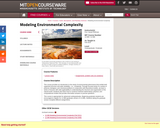
This course provides an introduction to the study of environmental phenomena that exhibit both organized structure and wide variability - i.e., complexity. Through focused study of a variety of physical, biological, and chemical problems in conjunction with theoretical models, we learn a series of lessons with wide applicability to understanding the structure and organization of the natural world. Students will also learn how to construct minimal mathematical, physical, and computational models that provide informative answers to precise questions.
- Subject:
- Applied Science
- Environmental Science
- Material Type:
- Full Course
- Provider:
- M.I.T.
- Provider Set:
- M.I.T. OpenCourseWare
- Author:
- Daniel Rothman
- Date Added:
- 01/01/2014
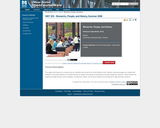
The origins and reasons for monarchy as an institution and social force in the Western world. Specific royal personages are studied with attention to how they attained or lost effectiveness as leaders; their goals for themselves and their people are stressed. These themes are explored through primary source readings. Architectural, artistic, and musical evidence are introduced in slide and tape sessions.
- Subject:
- Applied Science
- Architecture and Design
- Arts and Humanities
- History
- World History
- Material Type:
- Full Course
- Homework/Assignment
- Syllabus
- Provider:
- UMass Boston
- Provider Set:
- UMass Boston OpenCourseWare
- Author:
- Professor Aidan Breen
- Date Added:
- 05/23/2019
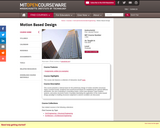
Presents a rational basis for the preliminary design of motion-sensitive structures. Topics include: analytical and numerical techniques for establishing the optimal stiffness distribution, the role of damping in controlling motion, tuned mass dampers, base isolation systems, and an introduction to active structural control. Examples illustrating the application of the motion-based design paradigm to building structures subjected to wind and seismic excitation are discussed.
- Subject:
- Applied Science
- Environmental Science
- Material Type:
- Full Course
- Provider:
- M.I.T.
- Provider Set:
- M.I.T. OpenCourseWare
- Author:
- Connor, Jerome
- Date Added:
- 01/01/2003